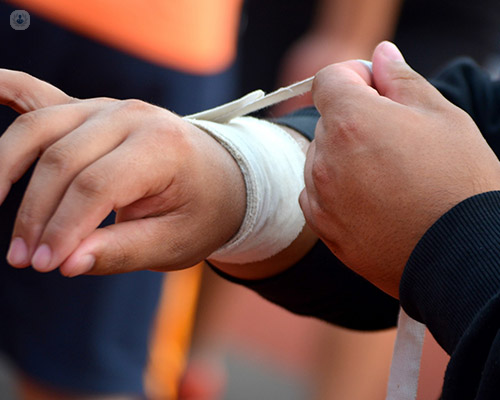Hand tendonitis
Mr Amit Putti - Orthopaedic surgery
Created on: 03-21-2017
Updated on: 10-05-2023
Edited by: Conor Lynch
What is wrist/hand tendonitis?
Tendonitis is a common condition which happens when a tendon swells and becomes painful after an injury. Wrist and hand tendonitis affects the tendons around the wrist and hand joints, causing them to become inflamed and irritated. It usually affects one tendon in the wrist and hand, but it may involve more.
Tendons connect muscles in the body to the bones, and tendons which are found in the wrist connect the muscles found in the forearm to the bones in the hand, and finger bones. There are various tendons surrounding the wrist, and any one of them can become inflamed and irritated, causing pain or discomfort when moving the wrist.

What are the symptoms?
Usually, patients complain that they feel pain in the wrist. They may also notice swelling, and the tendons may feel warmer than they usually do. Some redness may be apparent. Sometimes. patients report that they feel a ‘grinding’ sensation from the affected tendons.
What causes hand tendonitis?
Hand and wrist problems usually occur through injury, general wear and tear, or overuse. Tendonitis can be caused by an injury, but more often it is caused through repetition of the same movement over a period of time. These movements can lead to overuse, which in turn can cause tendonitis.
How is hand tendonitis treated?
Many cases of tendonitis heal over time with self-care and the proper home treatment, with the main aim being to relieve pain and reduce inflammation. Resting the wrist, supporting it with a bandage, and applying ice on the injury can help swelling to go down and help reduce pain. Taking painkillers can help with mild pain.
However, not all cases can be treated through lifestyle modifications and home treatments. In some circumstances, doctors may recommend specific medications, like anti-inflammatories or corticosteroids. Muscles and tendons also may need strengthening, and physiotherapy can help with this.
In more long-term or severe cases, surgery may be recommended to repair the tendon and remove the damaged tissue.
How can it be prevented?
Like many wrist and hand injuries, tendonitis cannot really be prevented, but risks can be minimised by taking care of your body and avoiding movements or activities which can put strain on it.
To prevent tendonitis as far as is possible, make sure to warm up correctly when doing exercise, and stretch properly when cooling down. Avoid repetitive movements, and take breaks to minimise strain or overuse.
Which specialist treats hand tendonitis?
Orthopaedic surgeons are the specialists that treat hand tendonitis.






